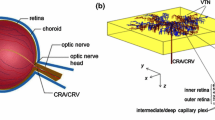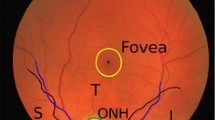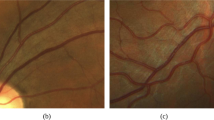Abstract
The retinal microvasculature is a window to the systemic circulation. Systemic diseases, like diabetes and hypertension, are linked to retinal microvascular structure changes (as width, tortuosity, and branching angle). The latter results in a potentially disadvantageous blood flow. This study has been designed to examine the relationship of a retinal vascular tortuosity to both blood pressure and velocity. The geometrical outlines of realistic retinal vascular trees have been extracted from fundus images. The retinal venular tortuosity has been quantitatively measured. A normal tortuosity value has been found, which has not exceeded 1.2. A computational fluid dynamics study has been conducted to examine the effect of topological changes on the hemodynamics distribution in the retinal circulation. The microvascular diameter effect (i.e., Fahraeus–Lindqvist effect) and the hematocrit have been considered in determining the viscosity of the blood in the retinal vessel segments. The pressure drop and the maximum velocity have been in the order of 15 mmHg and 0.032 m/s for tortuous vessels, and 13 mmHg and 0.054 m/s for normal vessels, respectively. For a clinical case, the maximal velocity falls down to 14 % due to the tortuosity. The current results have shown a decrease in the blood velocity and an increase in the pressure drop with tortuosity, which are in good agreement with in vivo measurements reported in the literature.





















Similar content being viewed by others
Abbreviations
- k :
-
Matched filter kernel
- L :
-
Length of the vessel segment
- σ :
-
Spread of the intensity profile
- d curve :
-
Distance traversed by the vessel (pixels)
- x i , y i :
-
Coordinates of the ith pixel in the vessel segment
- N :
-
Total number point constituent vessel segment
- d straight :
-
Distance between the first and last points of the vessel (pixels)
- Tortuosity:
-
Tortuosity of blood vessels
- v :
-
Blood velocity (m/s)
- p :
-
Pressure (Pa)
- ρ :
-
Density (kg/m3)
- µ :
-
Dynamic viscosity
- µ rel :
-
Relative viscosity
- µ 0.45 :
-
Relative viscosity for a fixed discharge hematocrit
- D :
-
Vessel diameter
- C :
-
Describes the shape of viscosity dependence on hematocrit
- f :
-
Gravity forces
References
Acheson DJ (1990) Elementary fluid dynamics: Oxford applied mathematics and computing science series. Clarendon Press, Oxford
Arsene S, Giraudeau B, Le Lez ML, Pisella PJ, Pourcelot L, Tranquart F (2002) Follow up by colour Doppler imaging of 102 patients with retinal vein occlusion over 1 year. Br J Ophthalmol 86(1):1243–1247
Baxter GM, Williamson TH (1996) The value of serial Doppler imaging in central retinal vein occlusion: correlation with visual recovery. Clin Radiol 51(6):411–414
Brown DL, Cortez R, Minion ML (2001) Accurate projection methods for the incompressible Navier–Stokes equations. J Comput Phys 168(2):464–499
Bullitt E, Gerig G, Pizer SM, Lin W, Aylward SR (2003) Measuring tortuosity of the intracerebral vasculature from MRA images. IEEE Trans Med Imaging 22(9):1163–1171
Chaudhuri S, Chatterjee S, Katz N, Nelson M, Goldbaum M (1989) Detection of blood vessels in retinal images using two-dimensional matched filters. IEEE Trans Med Imaging 8(3):263–269
Cheung CY, Zheng Y, Hsu W, Lee ML, Lau QP, Mitchell P, Wang JJ, Klein R, Wong TY (2011) Retinal vascular tortuosity, blood pressure, and cardiovascular risk factors. Ophthalmology 118(5):812–818
Constantin JP, Riva CE (2013) Retinal blood flow evaluation. Ophthalmologica 229(2):61–74
Curtis TM, Gardiner TA, Stitt AW (2009) Microvascular lesions of diabetic retinopathy: clues towards understanding pathogenesis? Eye (Lond) 23(7):1496–1508
Daniels SR, Lipman MJ, Burke MJ, Loggie JM (1993) Determinants of retinal vascular abnormalities in children and adolescents with essential hypertension. J Hum Hypertens 7(3):223–228
David AS (2002) Image-based computational fluid dynamics modeling in realistic arterial geometries. Ann Biomed Eng 30(4):483–497
Dougherty G, Johnson MJ, Wiers MD (2010) Measurement of retinal vascular tortuosity and its application to retinal pathologies. Med Biol Eng Comput 48(1):87–95
Duker J, Weiter JJ (1991) Ocular circulation. In: Tasman W, Jaeger EA (eds) Duane’s foundations of clinical ophthalmology. JB Lippincott, New York, pp 1–34
Durham JT, Herman IM (2011) Microvascular modifications in diabetic retinopathy. Curr Diab Rep 11(4):253–264
Fahraeus R (1929) The suspension stability of the blood. Physiol Rev 9(2):241–274
Fahraeus R, Lindqvist T (1931) The viscosity of the blood in narrow capillary tubes. Am J Physiol 96:562–568
Fung YC (1993) Biomechanics, mechanical properties of living tissues. Springer, New York
Gabryś E, Rybaczuk M, Kędzia A (2006) Blood flow simulation through fractal models of circulatory system. Chaos Solitons Fractals 27(1):1–7
Ganesan P, He S, Xu H (2010) Development of an image-based network model of retinal vasculature. Ann Biomed Eng 38(4):1566–1585
Ganesan P, He S, Xu H (2010) Analysis of retinal circulation using an image based network model of retinal vasculature. Microvasc Res 80(1):99–109
Ganesan P, He S, Xu H (2011) Modelling of pulsatile blood flow in arterial trees of retinal vasculature. Med Eng Phys 33(7):810–823
Ganesan P, He S, Xu H (2011) Development of an image-based model for capillary vasculature of retina. Comput Methods Programs Biomed 102(1):35–46
Grisan E, Foracchia M, Ruggeri A (2003) A novel method for the automatic evaluation of retinal vessel tortuosity. In: Proceedings of the 25th annual international conference of the IEEE engineering in medicine and biology society, 17–21 Sept 2003, vol 1, pp 866–869. doi:10.1109/IEMBS.2003.1279902
Grunwald JE, Riva CE, Baine J, Brucker AJ (1992) Total retinal volumetric blood flow rate in diabetic patients with poor glycemic control. Invest Ophthalmol Vis Sci 33(2):356–363
Guidoboni G, Harris A, Carichino L, Arieli Y, Siesky BA (2014) Effect of intraocular pressure on the hemodynamics of the central retinal artery: a mathematical model. Math Biosci Eng 11(3):523–546
Guran T, Zeimer RC, Shahidi M, Mori MT (1990) Quantitative analysis of retinal hemodynamics using targeted dye delivery. Invest Ophthalmol Vis Sci 31(11):2300–2306
Han HC (2012) Twisted blood vessels: symptoms, etiology and biomechanical mechanisms. J Vasc Res 49(3):185–197
Harris A, Guidoboni G, Arciero JC, Ameriskandari A, Tobe LA, Siesky BA (2013) Ocular hemodynamics and glaucoma: the role of mathematical modeling. Eur J Ophthalmol 23(2):139–146
Hart WE, Goldbaum M, Côté B, Kube P, Nelson MR (1999) Measurement and classification of retinal vascular tortuosity. Int J Med Inform 53(2–3):239–252
Heistad DD (2001) What’s new in the cerebral microcirculation? Microcirculation 8(6):365–375
Heneghan C, Flynn J, O’Keefe M, Cahill M (2002) Characterization of changes in blood vessel width and tortuosity in retinopathy of prematurity using image analysis. Med Image Anal 6(4):407–429
Hubbard LD, Brothers RJ, King WN, Clegg LX, Klein R, Cooper LS, Sharrett AR, Davis MD, Cai J (1999) Methods for evaluation of retinal, microvascular abnormalities associated with hypertension/sclerosis in the atherosclerosis risk in communities study. Ophthalmology 106(12):2269–2280
Iftimia NV, Hammer DX, Bigelow CE, Rosen DI, Ustun T, Ferrante AA, Vu D, Ferguson RD (2006) Toward noninvasive measurement of blood hematocrit using spectral domain low coherence interferometry and retinal tracking. Opt Express 14(8):3377–3388
Irene EV, Figueroa CA, Jansen KE, Taylor CA (2006) Outflow boundary conditions for three-dimensional finite element modeling of blood flow and pressure in arteries. Comput Methods Appl Mech Eng 195(29–32):3776–3796
Jensen PS, Glucksberg MR (1998) Regional variation in capillary hemodynamics in the cat retina. Invest Ophthalmo Vis Sci 39(2):407–415
Jintao Y, Yi L, Simon T, Grant C, Lin W (2014) Parametric transfer function analysis and modeling of blood flow autoregulation in the optic nerve head. Int J Physiol Pathophysiol Pharmacol 6(1):13–22
Kalitzeos AA, Lip GY, Heitmar R (2013) Retinal vessel tortuosity measures and their applications. Exp Eye Res 106:40–46. doi:10.1016/j.exer.2012.10.015
Kramer CK, Rodrigues TC, Canani LH, Gross JL, Azevedo MJ (2011) Review diabetic retinopathy predicts all-cause mortality and cardiovascular events in both type 1 and 2 diabetes: meta-analysis of observational studies. Diabetes Care 34(5):1238–12244
Kwa VI, van der Sande JJ, Stam J, Tijmes N, Vrooland JL (2002) Retinal arterial changes correlate with cerebral small-vessel disease. Neurology 59(10):1536–1540
Kylstra JA, Wierzbicki T, Wolbarsht ML, Landers MB, Stefansson E (1986) The relationship between retinal vessel tortuosity, diameter, and transmural pressure. Graefes Arch Clin Exp Ophthalmol 224(5):477–480
Lee J, Smith NP (2012) The multi-scale modelling of coronary blood flow. Ann Biomed Eng 40(11):2399–2413
Liu D, Wood NB, Witt N, Hughes AD, Thom SA, Xu XY (2009) Computational analysis of oxygen transport in the retinal arterial network. Curr Eye Res 34(11):945–956
Malek J, Tourki R (2013) Blood vessels extraction and classification into arteries and veins in retinal images. In: 10th International Multi-Conference on Systems, Signals & Devices (SSD), 18–21 March 2013, Hammamet, Tunisia, pp 1–6. doi:10.1109/SSD.2013.6564037
Malek J, Nasralli B, Echouchene F, Tourki R (2013) Geometric and hemodynamic study in early stages of diabetic retinopathy. In: International conference on control, engineering and information technology, Jun 4–7, 2013, Sousse, Tunisia, pp 69–76
Myron Y, Jay SD, James JA (2009) Ophthalmology, 3rd edn. Elsevier, Mosby, pp 518–521
Onkaew D, Turior R, Uyyanonvara B, Akinori N, Sinthanayothin C (2011) Automatic retinal vessel tortuosity measurement using curvature of improved chain code. In: 2011 International conference on electrical, control and computer engineering (INECCE), 21–22 June 2011, Pahang, pp 183–186. doi:10.1109/INECCE.2011.5953872
Olufsen MS (1999) A structured tree outflow condition for blood flow in the larger systemic arteries. Am J Physiol 276(1 Pt 2):H257–H268
Papenfuss HD, Gross JF (1981) Microhemodynamics of capillary networks. Biorheology 18(3–6):673–692
Pries AR, Secomb TW, Gaehtgens P, Gross JF (1990) Blood flow in microvascular networks experiments and simulation. Circ Res 67(4):826–834
Pries AR, Secomb TW, Gaehtgens P (1996) Biophysical aspects of blood flow in the microvasculature. Cardiovasc Res 32(4):654–667
Pries AR, Secomb TW (2011) Microcirculatory blood flow: functional implications of a complex fluid. In: 3rd micro and nano flows conference, Thessaloniki, Greece, 22–24 August 2011, Brunel University, pp 22–24. ISBN: 978-1-902316-98-7
Qiao A, Guo X, Wu S, Zeng Y, Xu X (2004) Numerical study of nonlinear pulsatile flow in S-shaped curved arteries. Med Eng Phys 26(7):545–552
Quarteroni A, Veneziani A, Zunino P (2002) Mathematical and numerical modelling of solute dynamics in blood flow and arterial walls. SIAM J Numer Anal 39(5):1488–1511
Quarteroni A, Formaggia L (2004) Mathematical modeling and numerical simulation of the cardiovascular system. In: Ciarlet PG, Lions JL (eds) Modeling of living systems. Elsevier, Amsterdam
Rannacher R (1999) Finite element methods for the incompressible Navier Stokes equations. Preprint Institute of Applied Mathematics, University of Heidelberg, Heidelberg
René MW, Dragostinoff N, Palkovits S, Told R, Boltz A, Leitgeb RA, Gröschl M, Garhöfer G, Schmetterer L (2012) Measurement of absolute blood flow velocity and blood flow in the human retina by dual-beam bidirectional Doppler Fourier-domain optical coherence tomography. Invest Ophthalmol Vis Sci 53(10):6062–6071
Riva CE, Grunwald JE, Sinclair SH, Petrig BL (1985) Blood velocity and volumetric flow rate in human retinal vessels. Invest Ophthalmol Vis Sci 26(8):1124–1132
STARE Project Website (1978) Clemson University, Clemson, SC (Online), VIII(4):283–298. http://www.ces.clemson.edu/ine
Steele BN, Olufsen MS, Taylor C (2007) Fractal network model for simulating abdominal and lower extremity blood flow during resting and exercise conditions. Comput Methods Biomech Biomed Eng 10(1):39–51
Stodtmeister R, Ventzke S, Spoerl E, Boehm AG, Terai N, Haustein M, Pillunat LE (2013) Enhanced pressure in the central retinal vein decreases the perfusion pressure in the prelaminar region of the optic nerve head. Invest Ophthalmol Vis Sci 54(7):4698–4704
Sun N, Wood NB, Hughes AD, Thom S, Xu XY (2006) Fluid-wall modeling of mass transfer in an axisymmetric stenosis: effects of shear-dependent transport properties. Ann Biomed Eng 34(7):1119–1128
Takahashi T, Nagaoka T, Yanagida H, Saitoh T, Kamiya A, Hein T, Kuo L, Yoshida A (2009) A mathematical model for the distribution of hemodynamic parameters in the human retinal microvascular network. J Biorheol 23(2):77–86
Williamson-Noble FA (1952) Venous pulsation. Trans Ophthalmol Soc 72:317–326
Williamson TH, Baxter GM (1994) Central retinal vein occlusion, an investigation by color Doppler imaging. Blood velocity characteristics and prediction of iris neovascularization. Ophthalmology 101(8):1362–1372
Witt N, Wong TY, Hughes AD, Chaturvedi N, Klein BE, Evans R, McNamara M, Thom SA, Klein R (2006) Abnormalities of retinal microvascular structure and risk of mortality from ischemic heart disease and stroke. Hypertension 47(5):975–981
Wolffsohn JS, Napper GA, Ho SM, Jaworski A, Pollard TL (2001) Improving the description of the retinal vasculature and patient history taking for monitoring systemic hypertension. Ophthalmic Physiol Opt 21(6):441–449
Xie X, Wang Y, Zhu H, Zhou H, Zhou J (2013) Impact of coronary tortuosity on coronary blood supply: a patient-specific study. PLoS One 8(5):e64564–e64564
Zhong Z, Song H, Chui TY, Petrig BL, Burns SA (2011) Noninvasive measurements and analysis of blood velocity profiles in human retinal vessels. Invest Ophthalmol Vis Sci 52(7):4151–4157
Zvia BE (2012) The effect of diabetes mellitus on retinal function. In: Mohammad SO (ed) Diabetic retinopathy, InTech, pp 207–208. ISBN 978-953-51-0044-7
Acknowledgments
We would like to thank Dr Mehdi TEKARI and Dr Heykel Kamoun at the International Ophthalmology Clinic of Tunisia for providing images needed to conduct the present study.
Author information
Authors and Affiliations
Corresponding author
Rights and permissions
About this article
Cite this article
Malek, J., Azar, A.T. & Tourki, R. Impact of retinal vascular tortuosity on retinal circulation. Neural Comput & Applic 26, 25–40 (2015). https://doi.org/10.1007/s00521-014-1657-2
Received:
Accepted:
Published:
Issue Date:
DOI: https://doi.org/10.1007/s00521-014-1657-2




